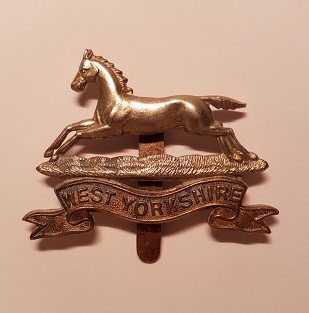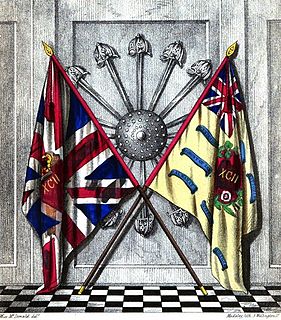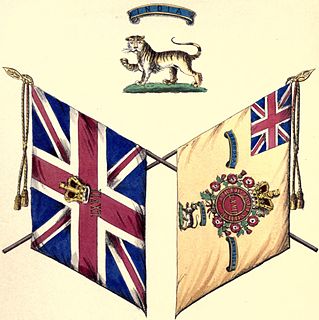
The West Yorkshire Regiment was an infantry regiment of the British Army. In 1958 it amalgamated with the East Yorkshire Regiment to form the Prince of Wales's Own Regiment of Yorkshire which was, on 6 June 2006, amalgamated with the Green Howards and the Duke of Wellington's Regiment to form the Yorkshire Regiment.

The 88th Regiment of Foot was an infantry Regiment of the British Army, raised in 1793. Under the Childers Reforms it amalgamated with the 94th Regiment of Foot to form the Connaught Rangers in 1881.
The 89th Regiment of Foot was a regiment of the British Army, raised on 3 December 1793. Under the Childers Reforms the regiment amalgamated with the 87th Regiment of Foot to form the Princess Victoria's in 1881.

The 92nd Regiment of Foot was a British Army infantry regiment, raised in 1794. Under the Childers Reforms it amalgamated with the 75th (Stirlingshire) Regiment of Foot to form the Gordon Highlanders in 1881.
The 38th Regiment of Foot was an infantry regiment of the British Army, raised in 1705. Under the Childers Reforms it amalgamated with the 80th Regiment of Foot to form the South Staffordshire Regiment in 1881.

The 72nd Highlanders was a British Army Highland Infantry Regiment of the Line. Raised in 1778, it was originally numbered 78th, before being redesignated the 72nd in 1786. Under the Childers Reforms it amalgamated with the 78th (Highlanders) Regiment to form the 1st Battalion of the Seaforth Highlanders in 1881.

The 31st (Huntingdonshire) Regiment of Foot was an infantry regiment of the British Army, raised in 1702. Under the Childers Reforms it amalgamated with the 70th (Surrey) Regiment of Foot to form the East Surrey Regiment in 1881.

The 71st Regiment of Foot was a Highland regiment in the British Army, raised in 1777. Under the Childers Reforms it amalgamated with the 74th (Highland) Regiment of Foot to become the 1st Battalion, Highland Light Infantry in 1881.

The East Yorkshire Regiment was a line infantry regiment of the British Army, first raised in 1685 as Sir William Clifton's Regiment of Foot and later renamed the 15th Regiment of Foot. It saw service for three centuries, before eventually being amalgamated with the West Yorkshire Regiment in 1958, to form the Prince of Wales's Own Regiment of Yorkshire. Subsequently, the regiment amalgamated with the Green Howards and the Duke of Wellington's Regiment to form the Yorkshire Regiment on 6 June 2006.

The 67th Regiment of Foot was a line infantry regiment of the British Army, raised in 1756. Under the Childers Reforms it amalgamated with the 37th Regiment of Foot to form the Hampshire Regiment in 1881.
The 69th Regiment of Foot was an infantry regiment of the British Army, raised in 1756. Under the Childers Reforms it amalgamated with the 41st (Welch) Regiment of Foot to form the Welch Regiment in 1881.
The 41st (Welch) Regiment of Foot was an infantry regiment of the British Army, raised in 1719. Under the Childers Reforms it amalgamated with the 69th Regiment of Foot to form the Welch Regiment in 1881.

The 39th (Dorsetshire) Regiment of Foot was an infantry regiment of the British Army, raised in 1702. Under the Childers Reforms it amalgamated with the 54th Regiment of Foot to form the Dorsetshire Regiment in 1881.
The 61st Regiment of Foot was an infantry regiment of the British Army, raised in 1756. Under the Childers Reforms it amalgamated with the 28th Regiment of Foot to form the Gloucestershire Regiment in 1881.

The 46th Regiment of Foot was an infantry regiment of the British Army, raised in 1741. Under the Childers Reforms it amalgamated with the 32nd (Cornwall) Regiment of Foot to form the Duke of Cornwall's Light Infantry in 1881, becoming the 2nd Battalion of the new regiment.

The 87th Regiment of Foot was an infantry regiment of the British Army, raised in 1793. Under the Childers Reforms it amalgamated with the 89th Regiment of Foot to form the Princess Victoria's in 1881.

The 86th Regiment of Foot was an infantry regiment of the British Army, raised in 1793. Under the Childers Reforms it amalgamated with the 83rd Regiment of Foot to form the Royal Irish Rifles in 1881.
The 59th Regiment of Foot was an infantry regiment of the British Army, formed in 1755 in response to the threat of renewed war with France. Under the Childers Reforms it amalgamated with the 30th (Cambridgeshire) Regiment of Foot to form the East Lancashire Regiment in 1881.
The 85th Regiment of Foot was a British Army line infantry regiment, raised in 1793. Under the Childers Reforms it amalgamated with the 53rd (Shropshire) Regiment of Foot to form the King's Shropshire Light Infantry in 1881.

The 90th Perthshire Light Infantry was a Scottish light infantry regiment of the British Army, raised in 1794. Under the Childers Reforms it amalgamated with the 26th (Cameronian) Regiment of Foot to form the Cameronians in 1881.
















